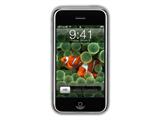3G iPhone
According to the Apple official website and some journalists who attended WWDC, the biggest update of the new iPhone - 3G iPhone is its support for 3G networks, which is 2.8 times faster than the previous generation.
In terms of appearance, Apple has not made too many changes; it looks almost identical to the previous generation from the front.
The details of the changes include: thickness reduced to 12.3mm, the back cover adopts a curved design, and has changed from metal material to plastic, while the buttons on the side of the body have been changed to metal material. A white back cover will also be available for the 16GB version. The headphone jack is located on the top surface, so there will no longer be an issue with headphones not being able to be inserted.
In addition, improvements have also been made in the design of the phone's sound quality.
One of the slogans used by Apple in its promotion of the iPhone 3G is "twice the speed, half the thickness."
According to one journalist after testing, the network speed of the iPhone 3G reaches 216Kbps, while the old EDGE version is 105Kbps. The claim by Apple that the speed is doubled is not exaggerated.
Hardware related:
In terms of hardware, this update by Apple seems somewhat unsatisfactory.
The screen, camera, and 802.11 b/g wireless network have not been upgraded, there is no front-facing camera, and Apple has not mentioned anything about 3G video calls anywhere.
A-GPS can comprehensively apply the built-in GPS and mobile network base stations for positioning, and supports adding geographical location tags to photos taken by the phone.
The actual feeling of holding the phone is thicker, but due to the curve on its back, it can give people a slim visual effect.
Fortunately, the plastic back cover does not feel cheap.
However, due to the use of high-gloss paint, the back and screen are now just as prone to collecting fingerprints. The iPhone 3G no longer comes with a dock, but only provides a USB power cord and dock adapter. Despite this, it includes a small tool for removing the SIM card.
Additionally, the problem of battery drain and system slowdown caused by background operation of mobile software has been solved.
The iPhone operating system does not allow third-party programs to run in the background. For this, Apple provides a development tool called Push Notification Service, which maintains a permanent IP connection between the Apple server and all iPhones. When third-party software needs to send messages to the iPhone, it requires the Apple server to send a request, then the notification server sends information to the iPhone.
For example, instant messaging software such as Skype and MSN do not need to run in the background. When you receive a new message, the service sends a reminder through the server to wake up the program for reception.
In addition, third-party software can also automatically upgrade via this function. This service will officially launch in September, but development tools can be provided to third-party software vendors starting next month.
3. Software related
Compared to the minor hardware upgrades, the software updates prepared by Apple for the iPhone 3G are likely to be more attractive.
The iPhone 2.0 firmware version to be announced in early July will support the App Store software store, allowing global developers to sell or freely distribute iPhone third-party software through this channel!
Other functions include: support for Apple iWork and Microsoft Office file formats, contact search, saving email attachments, parental controls, etc.
The iPhone 3G natively supports Exchange, providing enterprise functions such as email, contacts, calendar synchronization, and remote wiping.
First-generation iPhone users can upgrade to the 2.0 firmware version for free, while iPod touch users need to pay $9.99.
The iPhone 3G will be launched in 70 countries and regions around the world in the coming months, with the first batch of launches on July 11 including: Australia, Austria, Belgium, Canada, Denmark, Finland, France, Germany, Hong Kong, Ireland, Italy, Japan, Mexico, Netherlands, New Zealand, Norway, Portugal, Spain, Sweden, Switzerland, UK, and USA.
iPhone 3G tariff package and jailbreak details:
This is probably what most friends are most concerned about~ Regarding the pricing of the iPhone 3G, currently only the US region is confirmed to still be exclusively sold by AT&T.
The 8GB and 16GB versions are priced at $199 and $299 respectively, but require signing a two-year voice contract at the same time.
The monthly 3G data unlimited traffic subscription fee is $30, and $45 for corporate users, while the voice plan including 450 minutes of calls, 5000 minutes of weekend/night calls, and 200 text messages is $39.99 (there are also voice packages with more free call time and text messages), meaning that the minimum monthly cost for each iPhone user is approximately $70. Existing iPhone users upgrading to the iPhone 3G voice contract need to extend for 2 years, and users who purchased the old model after May 27 can upgrade to the iPhone 3G for free.
Apple has set the sales price for the iPhone 3G. Although AT&T doesn't have to share costs with Apple anymore, the money lost on the iPhone 3G will be recovered from usage fees. Since AT&T doesn't have to split voice charges with Apple, the activation policy for the iPhone 3G will be stricter, requiring on-site activation at Apple or AT&T specialty stores, and online sales will no longer be conducted.




